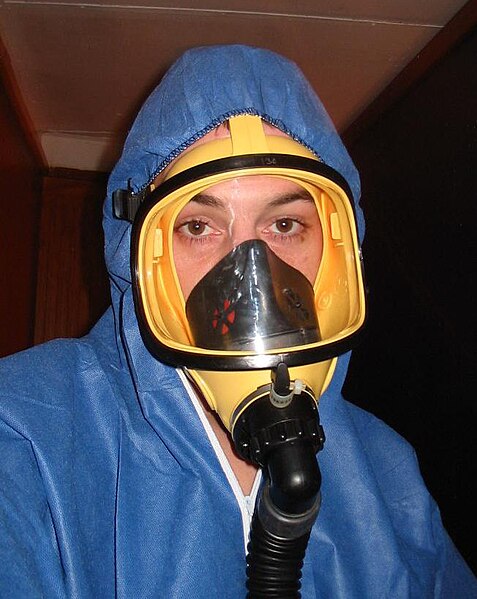A Racal suit is a protective suit with a powered air-purifying respirator (PAPR). It consists of a plastic suit and a battery-operated blower with HEPA filters that supplies filtered air to a positive-pressure hood. Racal suits were among the protective suits used by the Aeromedical Isolation Team (AIT) of the United States Army Medical Research Institute of Infectious Diseases to evacuate patients with highly infectious diseases for treatment.
Racal suits used at the United States Army Medical Research Institute of Infectious Diseases
Details of the suit components
Powered air-purifying respirator
A powered air-purifying respirator (PAPR) is a type of respirator used to safeguard workers against contaminated air. PAPRs consist of a headgear-and-fan assembly that takes ambient air contaminated with one or more type of pollutant or pathogen, actively removes (filters) a sufficient proportion of these hazards, and then delivers the clean air to the user's face or mouth and nose. They have a higher assigned protection factor than filtering facepiece respirators such as N95 masks. PAPRs are sometimes called positive-pressure masks, blower units, or just blowers.
A powered air-purifying respirator with a belt-pack filter-blower that feeds air to the elastomeric mask.
A PAPR, gown, and biosafety cabinet in use in a BSL-3 laboratory. All parts of the PAPR are visible: the waist unit holding the fan, filter, and battery; the hose; and the mask, in this case a flexible, loose-fitting one.
This full-face mask has an inner orinasal mask to reduce dead space, and, since it is being used against asbestos, exhalation valves (white). The hose connects to a PAPR filter-pump.
Racal suits consist of a PAPR combined with a separate protective suit. They are used in healthcare settings, in this case by the U.S. Army Aeromedical Isolation Team at Fort Detrick, Maryland





